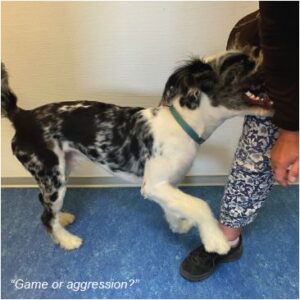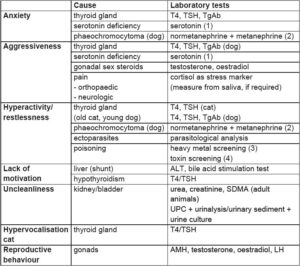If it is not a matter of education
Patients who display unwanted behaviour are normally only presented to the practice late in their history of suffering, since behaviour is usually not associated with an illness, but solely with the animal’s circumstances and its nature (Fig. 1).
However, abnormal behaviour can be caused by a wide variety of disorders. Increased aggressiveness can, for example, be caused by pain or hormones, but also infectious diseases – think of rabies, at worst – should be considered.
To differentiate, possible organic, hormonal, infectious, orthopaedic, genetic, autoimmune and allergic causes should be clarified. Furthermore, poisoning can also lead to problematic behaviour.
Among the many possible causes, the most common underlying diseases in our clinical laboratory consultation are listed here.
Organic diseases
Liver: Patients with portosystemic shunt may be presented to the practice for the first time because of apathy. Even if the affected dogs start behaving conspicuously by showing circular movements or by having epileptiform seizures, symptoms can be significantly milder and less specific, especially in case of an intrahepatic shunt. Clinical chemistry can become challenging as not all shunt patients show changes in liver values. Frequently, an isolated increase in ALT is observed. Diagnosis should thus be made by means of a bile acid stimulation test or – if possible in-house – by measuring ammonia and also include an ultrasound scan.
Kidney and bladder: Diseases affecting these organs can also lead to unwanted behaviour. If, for example, puppies show signs of uncleanliness, congenital or acquired kidney or bladder problems should be considered, too. In addition to medical imaging, a urinalysis (status/sediment and urine culture) as well as the determination of the protein-creatinine ratio (UPC) are recommended. The determination of urea, creatinine and SDMA in serum is not always effective in puppies, as the growing organism has highly variable concentrations of these substrates in serum. Adult cats may show kidney-related uncleanliness which is often misinterpreted as a behavioural problem.
- Fig. 1: “Game or aggression”?
- Fig. 2: Effect of a leck of serotonin to the behaviour
- Tab. 1: Primary laboratory parameters to be determined relating to the most common behavioural problems
Hormonal imbalances
Behaviour is regulated by a variety of hormones and hormonal interactions. Changes in a single hormone level can trigger profound behavioural changes.
Thyroid gland: Diseases of the thyroid gland frequently occur in dogs and cats. In dogs, both cause and symptoms differ with age. In young dogs, it is autoimmune thyroiditis which leads to behavioural changes, whereas in older dogs these changes are caused by follicular atrophy.
In young dogs, anxious or aggressive behaviour with hyperactivity and severe educational problems is often associated with thyroid dysfunction. If these patients really suffer from thyroid-related behavioural problems, these are due to initial episodes of autoimmune thyroiditis with fluctuating hormone secretions. The diagnosis is confirmed by measuring the T4 and TSH levels but, above all, by determining the thyroglobulin antibodies (TgAb) as well as T3- and T4-antibodies.
In older dogs, hypothyroidism is one of the most common known endocrine disorders. Some of the first changes that are observed are increasing reluctance to move and lethargy. As the function of the thyroid gland can be influenced by many other diseases, it is necessary to determine the T4 and TSH levels and to rule out other conditions in order to confirm the diagnosis.
The clinical signs triggered by hyperthyroidism in older cats (weight loss, hyperactivity) often lead to a quick diagnosis. Only rarely, hyperthyroid cats are apathetic. In most cases, measuring the T4 level in serum is sufficient; in uncertain cases, TSH can be measured.
Gonads/adrenal gland: Sex steroids are responsible for a complex system of behaviours. The castration of domesticated animals and, thus, the suppression of gonadal function is frequently performed and significantly influences the behaviour. Not only the reproductive ability but especially aggressive behaviour against conspecifics should be suppressed. In case of dominance problems, it is also expected that castration will make it easier to guide the dogs.
If the dog or the cat continues to show sexual behaviour despite being neutered, the question arises as to whether there is still some gonadal tissue present. Determining the luteinising hormone (LH) as well as steroid hormones and particularly the measurement of the anti-Müllerian hormone (AMH) level in both male and female animals can help to answer this question.
Endocrine neoplasms can also manifest themselves through behavioural change. In the early phase, this may even be the only clinical sign. Sertoli cell tumours cause male dogs to become attractive to other males and to behave more like being neutered due to increased oestrogen secretion. Granulosa cell tumours in female dogs can mimic the behaviour of a pregnant bitch with nest-building behaviour and carrying around soft toys if hormone secretion, especially progesterone, is low but constant. It is alarming for the owner that no previous heat was observed and, thus, a false pregnancy is unlikely.
Endocrine active adrenal tumours lead to various behavioural changes depending on the hormonal secretion pattern. While Cushing’s syndrome, which is common in dogs, is primarily associated with increased appetite up to allotriophagia, other tumours of the adrenal cortex are rare. A rather common tumour of the adrenal medulla is the catecholamine-secreting phaeochromocytoma. The permanently elevated level of catecholamine in the blood results in increased restlessness and anxiety in patients. Determining the catecholamines normetanephrine and metanephrine in blood plasma or the normetanephrine- and metanephrine-creatinine ratio in urine helps to confirm the diagnosis.
Neurotransmitters
Recently, clinical laboratory testing of dogs with behavioural problems has started to focus on the “happiness hormone” serotonin. Serotonin is a neurotransmitter whose effects in the CNS include the inhibition of fear and aggression. A lack of serotonin in the CNS therefore leads to fearful-aggressive behaviour. Although serotonin cannot cross the blood-brain barrier, low serotonin levels in the blood correlate with certain behavioural problems. This correlation has been confirmed by our own research (Fig. 2).
Therefore, measuring serotonin in serum is recommended for dogs with fearful-aggressive behaviour. In addition to food supplementation with tryptophan, treatment can be carried out with serotonin analogues or serotonin reuptake inhibitors. A return to normal behaviour can be expected after a few weeks.
Infectious causes
It is the tactic of some infectious agents to manipulate their host’s behaviour with the aim of being transferred to a new host more quickly. A typical example for this is an infection with the rabies virus. Fortunately, rabies only plays a very minor role in Germany. Nevertheless, it may be a differential diagnosis in animals from uncontrolled imports and should be considered if dogs are aggressive.
But even less dramatic and much more frequent infections can also lead to behavioural changes. Especially ectoparasites living in the fur or on the skin can lead to increased restlessness without causing massive itching at the same time. Infected hair can be sent in to identify the parasite.
Poisoning
The intake of foreign substances is another way in which unwanted behaviour can be triggered. Lead poisoning manifests itself in various ways with restlessness, agitation, increased barking or biting and depression. If the dog ingests nicotine through cigarette butts, it leads to agitation and hyperactivity. It also frequently happens that animals take drugs if the owner does not handle the drugs carefully. Depending on the drug and dosage, behaviour can vary and range from hyperexcitability to somnolence. A single intake of poison results in a sudden change in behaviour and, at a higher dose, is usually associated with further symptoms.
Genetic behavioural problems
Particularly in pedigree animals, there are various genetic defects that are associated with behavioural change. These include, for example, neuronal ceroid lipofuscinosis (restlessness, aggressiveness, anxiety), acral mutilation syndrome (paw chewing), glycogen storage disease (lethargy), necrotising meningoencephalitis (disorientation, head shaking, circling), dopamine transporter polymorphism (hereditary behavioural abnormality in Malinois dogs: reduced excitability, episodic aggression) and many more. The causative mutations have already been identified in numerous breeds, which is why the option of diagnosing hereditary diseases in pedigree dogs with behavioural problems should also be taken into account. Especially for dogs, we offer an extensive and constantly growing range of tests. For more information, see https://shop.labogen.com/
Primary laboratory parameters to be determined relating to the most common behavioural problems (Tab. 1).
(1) Send in cooled (possibly frozen) and protected from light
(2) Frozen EDTA plasma, urine acidified with HCI to pH < 2, send in frozen and protected from light
(3) EDTA whole blood
(4) Only possible from urine; always state clinical history.
Dr. Ruth Klein






